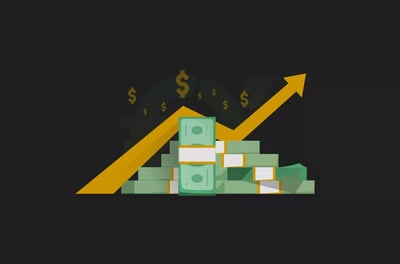Table Of Contents
- What Does a Strong Dollar Mean?
- Three Factors That Drive the US Dollar
- Supply and demand forces impacting dollar value
- Sentiment about dollar value
- Market factors that impact the dollar
- Why Is the Dollar Strong?
- The US economy is in better health
- The dollar’s safe-haven status
- Europe in trouble
- Buying government bonds
- The UK’s policy debacle
- China’s challenges
- Crypto’s dark times
- Impacts of the Strong Dollar on Different Groups
- Impact on professional and institutional investors
- Impact on retail investors
- Impact on American consumers
- Impact on American manufacturers
- The Bottom Line
Why Is The US Dollar So Strong?
Virtually every financial asset class underperformed in 2022, except perhaps for the US dollar. In fact, the greenback appreciated mightily during the year as the US Federal Reserve increased interest rates aggressively to control soaring inflation. While other economies struggled post-COVID, the US economy rallied.
The dollar became a juggernaut, forcing even strong currencies like the British pound and euro to struggle to keep up. Emerging economies bore the brunt of the dollar’s strength as their foreign imports and overseas debt repayment costs shot up. The US dollar Index, which tracks the American currency against a range of peer currencies, rose by almost 20% that year.
The dollar’s strength is even more impressive when compared with the performance of stocks, bonds, real estate and cryptocurrencies, which all suffered differing levels of underperformance. Many people wonder why the US dollar is so perennially strong and what it means for them going forward. In this article, we will explain what a strong dollar means for all parties, including FOREX traders, who invest in it.
A strong dollar attracts global investors because it’s seen as a safe haven during economic uncertainty
Global demand for US bonds and goods increases dollar strength due to required dollar-denominated payments
Market sentiment favors the dollar thanks to a strong US job market and proactive monetary policy
Other major economies like the UK, Europe, and China have struggled with crises that weakened their currencies
Retail investors must follow macro events closely to understand how a strong dollar affects their portfolio
A strong dollar benefits American consumers but hurts exporters and emerging markets with dollar debt
Traders should track the US Dollar Index and economic indicators to gauge ongoing currency strength

What Does a Strong Dollar Mean?
The strength of a currency is measured in relation to other currencies. Economic events and geopolitical news are some of the factors that cause the relative strength of a currency to lose or gain. In the case of the US dollar, its current strength, in simple terms, is a result of the fact that its policymakers have navigated economic shocks better, and the currency itself is seen as a safe haven. We will discuss this idea in more detail later in the article.
Let's use 2022 as a test case year. Inflation was a global problem that required the attention of governments and monetary policymakers. The high inflation has its roots in the COVID-19 pandemic, which forced economies to adopt expansionary policies that saw them make cheap money available to encourage spending. Once the world moved past the pandemic, citizens across the globe started spending, albeit a little too fast, causing global economies to overheat through inflation.
The US Federal Reserve was the most aggressive central bank in dealing with inflation. Its hawkish monetary policy stance saw it raise the federal interest rate from nearly zero at the beginning of 2022 to over 6% by the end of the cycle. This allowed the dollar to be viewed as well-managed and stable, and, in turn, it attracted purchasing inflows from investors who bought dollars in large volumes. This drove the strength of the dollar up due to increased demand.
Advanced economies, including the UK, Australia, the EU, and Japan, were slower to tackle inflation, causing the market to lose faith in them. This created negative sentiment around whether it was a good idea to buy their currencies.
European economies, in particular, faced challenges from Russia’s war on Ukraine, especially in the form of markedly higher energy costs and other commodities. Asian powerhouses like Japan and China struggled with lower global demand for manufactured goods, which made up most of their exports. Therefore, US dollar strength came, and still does, from global investors buying up large amounts of US dollars, and selling other currencies in turn. This increases the value of the greenback while selling other currencies weakens their value.
Three Factors That Drive the US Dollar
You might wonder if the reasons for the US dollar’s strength are a one-off. Typically, three main factors drive the strength of the dollar. We will discuss each of these in turn:
Supply and demand forces impacting dollar value
By virtue of it being the largest economy in the world, products and services from the US are imported by other countries and must be paid for in US dollars. This creates a demand for dollars because these purchases must be settled in that currency.
Also, when investors buy US bonds, be they government or corporate, they must be paid for in US dollars. One of the features of the prevailing climate in our test year was that bond yields increased, driving up demand for US bonds by institutional investors. This drove up demand for dollars.
Another major reason why the US dollar is often in demand in times of economic uncertainty is that it is a safe-haven investment that transcends geographical markets. Therefore, demand for dollars is always high, despite fluctuations in the performance of the US economy. At this point in time, demand for dollars is even higher than normal.
Sentiment about dollar value
When the US economy is perceived to be weak, such as when consumption slows due to increasing unemployment, a dollar sell-off occurs, meaning that investors return US dollars in preference for other currencies. The opposite scenario was at play in 2022 with the US having a strong job market. This, coupled with the fact that the US avoided a recession many investors thought was inevitable, led to sentiment around the dollar to be overwhelmingly positive, driving up demand.
Market factors that impact the dollar
High-end investors are constantly watching economic markers from data sources like government statistics, payroll data, national debt levels, and GDP figures. This helps traders better understand whether there will soon be a greater or lesser supply than the demand for dollars. These market factors can help drive the strength or weakness of the dollar.
Why Is the Dollar Strong?
Many traders view the dollar as the surest asset to buy in times of economic uncertainty. This safe-haven status comes from the American economy’s well-earned pre-eminence in global trade. Here are some other factors contributing to the current strength of the dollar:
The US economy is in better health
The proactive monetary policy is a big part of why the US economy is thought to be in good health. It starts with the Fed, raising interest rates aggressively to bring down inflation. Every move it makes is designed to tackle inflation, something not all central banks can claim. For example, the European Central Bank (ECB) has been blamed for being too dovish in the face of record inflation. The trickle-down effect of strong monetary policy management meant that even though inflation was high in the US, other key indicators, such as the jobs market, remained strong.
The dollar’s safe-haven status
The dollar’s rise also says something about what is happening in the rest of the world. There is a strong trend for the dollar to strengthen whenever the global economy is in crisis. Markets panic, investors flee to safety, and the dollar appreciates. When stock and bond markets turn unstable, investors flock to the safety of the dollar due to its status as the world's reserve currency.
Europe in trouble
The 2022 US economy was in better shape than Europe’s, which was in the midst of nearby war and was already likely in recession. Europe faced an energy crisis, meaning the fundamentals in Europe were quite weak when compared to the US. Also, investors were not as convinced that the ECB would be as proactive in containing inflation as the Fed.
Buying government bonds
Bonds are a way for governments and companies to borrow money. Government bonds are generally considered very safe. Every year, investors around the globe buy billions of dollars worth of US bonds. This extra demand pushes up the dollar's value.
The UK’s policy debacle
Part of the reason for the continued strength of the dollar is that another traditionally safe economy has had a terrible year in political and economic terms. The British pound hit a record low against the dollar on 26 September 2022, but has since recovered. The pound’s initial slump came after a self-inflicted blow caused by unfunded tax cuts and energy subsidies, news of which threw markets into turmoil. Many investors sold UK government bonds, and other UK financial assets, and bought US dollars instead.
China’s challenges
Another major economy suffered in other ways in the year of our test case. China, the second largest economy in the world, instituted a zero-COVID policy that caused an economic slowdown, as factories could not be as productive as usual. Also, China’s real estate market was in trouble, with property sales slumping by 25% that year alone. A cocktail of factors, including the aforementioned Zero-COVID strategy, saw property developers run out of capital to finish construction. This has resulted in hundreds of thousands of homebuyers refusing to pay their mortgage for delayed or stalled housing projects. With real estate estimated to be worth 30% of the country’s economy, the fallout caused an economic weakening that dampened investor sentiment.
Crypto’s dark times
Crypto had a year to forget. Crypto investors everywhere were trying to decide what to do in the face of an oncoming “crypto winter,” sparked by the collapse of crypto institutions like Terraform Labs and FTX. Already, Bitcoin’s all-time high of $69,000 seemed like a long time ago as investors sought to cut their losses in digital assets, further pushing crypto prices into basement territory. This saw investors flock to the safety of the US dollar.
Recommended Brokers
Impacts of the Strong Dollar on Different Groups
Different stakeholders have been affected by the dollar's strength in different ways. Here are just some:
Impact on professional and institutional investors
Volatility plays havoc with investor sentiment. A strong dollar causes US firms that earn a large percentage of their revenue overseas to revise their earnings forecasts. Companies like Microsoft Corporation have warned analysts and investors that future revenue could drop even more than expected thanks to a rising US dollar. This is because half of the company’s revenues come in foreign currency, meaning the company will earn fewer US dollars for these sales.
Emerging markets are also hit hard because many countries take out dollar-denominated debt and then service those with their respective currencies. When the dollar strengthens, they have to pay more, making it harder for them to honor their debts. Stocks that are based on technology firms or emerging markets are just two types of financial assets that will struggle in different ways, causing investors to move their money elsewhere.
Impact on retail investors
As a retail investor, you cannot hedge against currency volatility. You simply have to be in step with global developments so you can make the best trades for your strategy. At the outset, you should already be well aware of global events and their effect on your portfolio, but in times like these, you will need to pay extra attention to how things will affect you.
Impact on American consumers
These were the clear winners. Any imported goods or services bought in yuan, euros or pounds were now much cheaper than before, which was welcome news for consumers facing the strain of high inflation. A strong dollar can offset inflationary pressures by improving consumer spending.
Impact on American manufacturers
By contrast, American manufacturers did not have it all their own way. With the dollar the strongest it had been in 20 years against the euro, for example, US manufacturers are at a price disadvantage against overseas competitors. If their inputs are high, then the price of American manufacturers’ goods will be uncompetitive.
The Bottom Line
FAQ
It depends on which side of the fence you are sitting. A strong dollar may hurt US stocks, but it also makes international stocks more affordable for American investors who want to diversify their portfolios. A strong dollar makes imported goods cheaper for US consumers, but makes dollar-denominated debt repayments more expensive for emerging economies.
It is hard to say with certainty, but many analysts expect the dollar to remain strong as long as the US economy continues to outperform other big economies and the Federal Reserve continues to raise interest rates when needed. The idea of a coordinated response to the strong dollar by organizations like the World Bank and the IMF is not likely as these are slow-moving decision-making bodies. Analysts believe the market will play out in line with the actions of the participating economies.
The strength of the dollar has been a long trend lasting most of this year. Traders would be advised to pay close attention to market sentiment and technical factors, such as government data, for clues on when things could change. They could also watch the dollar index to see how major currencies are trending against the greenback. Mainly, it is business as usual as they keenly observe the fundamental factors that affect supply and demand.






